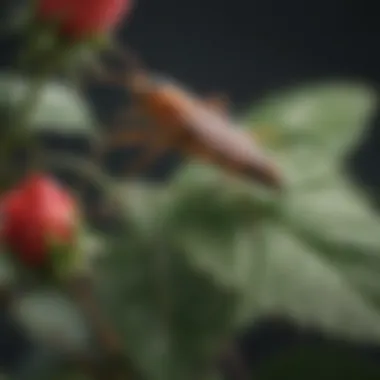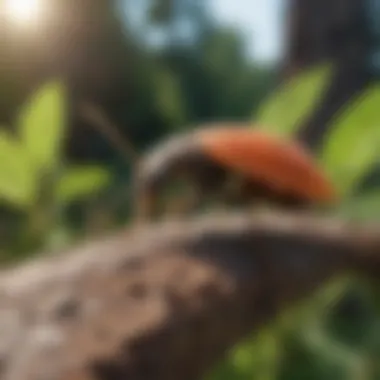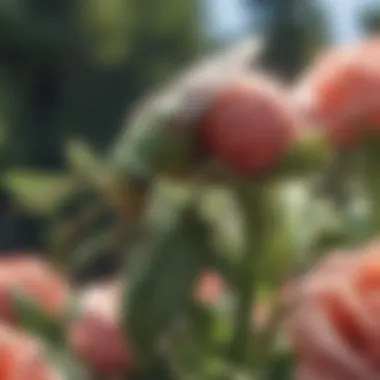Controlling Aphids on Rose Bushes: Effective Strategies


Intro
Aphids are small, sap-sucking insects that pose a considerable challenge to rose bushes. These tiny pests can quickly infest a garden, leading to damaged plants and diminished growth. Understanding how to control these infestations is crucial for anyone who wishes to maintain the health of their roses. This article will cover effective strategies for managing aphids, focusing on chemical, biological, and cultural practices. Also, preventive measures to stop aphids before they take hold will be addressed.
Fascinating Facts About Aphids
Unique Characteristics
Aphids are often overlooked because of their size. They can range from 1 to 10 millimeters long, and they come in various colors, including green, black, and yellow. One unique feature of aphids is their ability to reproduce rapidly. A single female aphid can give birth to dozens of offspring in just a week, leading to rapid population increases.
Extraordinary Abilities
Aphids also have an intriguing method of communication. They produce pheromones that can alert other aphids to danger. This ability helps them to collectively respond to threats by dropping to the ground or clustering together, making it harder for predators to pick them off.
Behavior and Habitat
Natural Habitats
Aphids thrive in diverse environments. Typically, they are found in gardens, particularly on plants with tender new growth. Rose bushes create a perfect habitat for them, as they provide both food and shelter. They prefer warm, sunny areas, which allow them to flourish with minimal threats from predators.
Feeding Habits
These insects feed on the sap of plants, which can cause wilting, yellowing, and stunted growth. Their feeding may also spread plant diseases, making it vital to address any infestation promptly.
Effective Control Strategies
Chemical Control
Using pesticides can be an immediate solution for aphid control. Products that contain imidacloprid or acetamiprid can effectively eliminate these pests. However, it is crucial to read and follow label instructions to minimize harm to beneficial insects and the environment.
Biological Control
Introducing natural predators, such as ladybugs or lacewings, can offer a sustainable way to keep aphid populations in check. These insects feed on aphids at various life stages, reducing their numbers significantly without the need for chemicals. Creating a habitat that supports these beneficial insects can enhance control.
Cultural Practices
Cultural methods involve modifying garden practices to create an environment less conducive to aphids. Regularly inspecting roses and promoting air circulation can help prevent infestations. Using companion plants, such as garlic or marigolds, can deter aphids as well.
Preventive Measures: Keeping plants healthy through proper irrigation and fertilization is essential for reducing susceptibility to aphids.
Synthesis of Information
Aphids present a challenge to the health of rose bushes, but various methods exist to control them effectively. Combining chemical, biological, and cultural strategies provides the best chance for maintaining healthy plants. Early detection and action are key to a successful approach. Knowledge of these strategies is essential for gardeners seeking to protect their rose gardens from these persistent pests.
Understanding Aphids
Understanding aphids is an essential first step for any gardener dealing with rose bushes. These pests are not just a nuisance; they can seriously hinder the growth and vitality of roses. By gaining insights into the nature and behavior of aphids, gardeners can better implement strategies to control and manage them. Knowing what aphids are, their life cycle, and the specific types that infest roses allows for targeted interventions that can significantly protect the health of the plants.
What Are Aphids?
Aphids are small, soft-bodied insects belonging to the family Aphididae. They typically measure 1 to 10 millimeters in length and come in various colors such as green, black, brown, or yellow. Aphids have specialized mouthparts that enable them to pierce plant tissues and extract sap, which serves as their primary food source. This feeding can weaken plants, stunting their growth and rendering them more susceptible to diseases. Furthermore, aphids excrete a sticky substance called honeydew, which can lead to the growth of sooty mold on roses, further impairing their aesthetic appeal and health.
Life Cycle of Aphids
Aphids have a rapid and complex life cycle that can complicate control measures. These insects reproduce in a few different ways, depending on their species and environmental conditions:
- Parthenogenesis: Many aphids can reproduce asexually, with females giving birth to live young without mating. This leads to a swift increase in population during favorable conditions.
- Sexual Reproduction: In autumn, some species produce winged individuals that migrate to new plants and mate. This results in the birth of eggs, which can survive harsh conditions.
Aphid populations can double in just a few days under optimal conditions, leading to large infestations that can overwhelm a rose bush.


Types of Aphids Affecting Roses
Several aphid species specifically target roses. Understanding which types are present can significantly help in managing infestations. Some common aphids that affect roses include:
- Green Peach Aphid (Myzus persicae): A frequent threat, known for its rapid reproduction and preference for new growth on roses.
- Black Fly (Aphis fabae): Often found on older stems and foliage, this aphid can cause substantial damage if not managed.
- Rose Aphid (Macrosiphum rosae): A species specialized to roses, leading to curling leaves and stunted growth.
Identifying the type of aphid can provide guidance on the most effective control strategies and how to integrate them into your rose care routines.
Understanding the biology of aphids and their impact on roses helps in formulating effective management strategies. By knowing the enemy, gardeners can effectively protect their prized blooms.
Impact of Aphids on Rose Bushes
Aphids have become a notable threat to rose bushes, impacting their growth, appearance, and overall vitality. Understanding the impact of these pests is essential for gardeners who want to maintain healthy and vibrant rose plants. Aphids feed on sap, which depletes the nutrients that roses require to thrive. Infestations can lead to wilting, yellowing of leaves, and a decline in bloom quality, ultimately affecting not just the health of the bush but the aesthetics of the entire garden.
Identifying the symptoms and consequences of aphid damage is crucial for taking corrective action. This understanding allows for timely intervention, ensuring that rose bushes can recover from infestations and continue to flourish.
Symptoms of Infestation
Recognizing the symptoms of an aphid infestation early can spare a rose bush from considerable damage. Primary indicators include:
- Curling leaves: New growth may curl inwards, causing a distorted appearance.
- Sticky residue: The presence of a sugary substance known as honeydew on leaves or surrounding areas indicates sap feeding by aphids.
- Visible aphids: These pests can be seen on the undersides of leaves, usually in clusters. They are small, often green or black, and can be mistaken for small specks.
- Sooty mold: The honeydew excreted by aphids promotes the growth of sooty mold, a black fungal growth that can cover leaves and block sunlight, further stressing the plant.
These signs serve as a prompt for action. Immediate measures can help manage the infestation before it escalates.
Consequences of Aphid Damage
The consequences of aphid damage extend beyond mere aesthetics. Affected rose bushes may experience several negative outcomes, including:
- Reduced growth: Continuous sap feeding stunts plant growth, resulting in smaller bushes and fewer blooms.
- Increased susceptibility to disease: Damaged plants are more vulnerable to infections and other pests, creating a compound problem for gardeners.
- Stunted blooms: Infestations can lead to fewer flowers or blooms that are underdeveloped, compromising the overall beauty of the rose bushes.
- Plant stress: Over time, stress from aphid activity can weaken the shrub, making recovery increasingly difficult.
Identifying Aphid Infestations
Identifying aphid infestations is a crucial step in the management of rose bushes. Early detection can prevent significant damage to the plants. Aphids can reproduce rapidly, leading to large populations that stress the plant's resources. Furthermore, recognizing an infestation early allows for the implementation of effective control methods, which is vital for maintaining plant health. It is important to discern between the various types of aphids affecting roses, as some may be more destructive than others. This knowledge also enables gardeners to tailor their interventions.
Visual Indicators of Aphids
Visual indicators are the first sign of aphid presence on rose bushes. Look for the following:
- Curled or Distorted Leaves: Aphids feed on the sap of plants. Their feeding causes leaves to curl, distort, or yellow, indicating potential infestation.
- Sticky Residue: Aphids excrete a syrupy substance known as honeydew. A shiny coating on leaves or ground below the plant can suggest their activity.
- Black Fungal Growth: Honeydew can also attract sooty mold growth, further impacting the plant’s aesthetics and health. Check for blackened patches on leaves.
Being vigilant for these indicators can help gardeners catch aphid problems early. Regular inspections during the growing season are recommended.
Methods for Monitoring Infestations
Monitoring is key to managing aphids effectively. A combination of methods provides a comprehensive approach:
- Regular Inspections: Schedule weekly checks during peak seasons. Look closely at new growth and the undersides of leaves where aphids commonly hide.
- Sticky Traps: Employ yellow sticky traps in the garden. Aphids are attracted to the color yellow, and capturing them can help measure their population levels.
- Physical Observation: Carry out visual surveys of neighboring plants as aphids can migrate. Observing nearby flora allows for better understanding of potential threats.
By using these monitoring methods, one can effectively assess the situation and respond accordingly. Proper identification and monitoring help mitigate the adverse effects of a growing aphid population on rose bushes.
Chemical Control Methods
Chemical control methods are essential in managing aphid populations on rose bushes. These methods can provide quick results and effectively reduce infestations. They play a critical role in an integrated pest management strategy. Understanding how to utilize chemical controls can make a significant difference in the health of rose bushes.
Insecticides: Efficacy and Application
Insecticides are commonly used to combat aphids due to their efficacy. These products work by targeting the physiological processes of the pests. Here are important points regarding their use:
- Types of Insecticides: Several formulations are available. These include pyrethroids, neonicotinoids, and insecticidal soaps. Each has distinct mechanisms of action.
- Mode of Action: For example, neonicotinoids affects the nervous system of insects. On the other hand, insecticidal soaps work by suffocating aphids.
- Application Timing: Timing is crucial for efficiency. Applying insecticides during early infestation stages yields better results.
- Spraying Technique: Ensure thorough coverage of infested areas. Underneath leaves, where aphids often dwell, requires special attention.


Utilizing these insecticides effectively can result in decreased aphid numbers and less negative impact on rose health.
Safety Considerations in Chemical Control
Safety is an important aspect of using chemical control methods. It is not just about killing the pests but also ensuring the safety of humans, pets, beneficial insects, and the environment.
- Read Labels: Always read the product labels before applying any insecticides. Follow dosage instructions carefully to prevent damage to plants.
- Application Precautions: Wear protective gloves and masks when handling chemicals. This reduces exposure risks during application.
- Impact on Beneficial Insects: Be cautious, as some chemicals may harm beneficial insects, such as ladybugs and lacewings, which naturally prey on aphids. Use targeted options that minimize collateral damage.
- Environmental Considerations: Consider the surrounding ecosystem when applying insecticides. Avoid application before rainfall, which can lead to runoff and potential contamination of local water sources.
The careful use of chemical controls can lead to a balanced approach to aphid management that protects both flower health and natural ecosystems.
In summary, chemical control methods are vital for managing aphid populations on rose bushes. Proper selection, application, and consideration of safety can optimize effectiveness and protect the surrounding environment.
Biological Control Methods
Biological control methods represent a pivotal strategy in managing aphid populations on rose bushes. Unlike chemical approaches that often disrupt the ecosystem, biological methods harness natural processes to diminish pest numbers. This strategy not only promotes plant health but also supports a sustainable gardening practice. Understanding the types of biological control available can significantly enhance the resilience of a rose garden against aphids.
Natural Predators of Aphids
Natural predators are crucial components of an integrated pest management strategy. Various insects prey on aphids, helping to keep their numbers in check. These predators include ladybugs, lacewings, and parasitic wasps. Incorporating these beneficial insects into your garden provides a bio-based approach to controlling aphid populations without harmful chemicals.
Benefits of Natural Predators:
- Reduction of Aphid Population: They consume aphids, leading to a significant decrease in their numbers.
- Eco-Friendly: No harmful residues are left on your plants, making it safe for children and pets.
- Ecosystem Balance: Supports the overall health of the garden ecosystem.
To attract these natural predators, gardeners can plant nectar and pollen-producing plants such as marigolds or yarrow. Ensuring a diverse garden will promote the survival of these beneficial insects. Furthermore, monitoring aphid populations and introducing predators at the right time can optimize their impact.
Natural predators of aphids can reduce the need for chemical interventions significantly, thus encouraging a healthier and more sustainable gardening environment.
Using Entomopathogenic Fungi
Entomopathogenic fungi offer an innovative route for controlling aphids. These fungi infect insects, ultimately leading to their death and therefore reducing aphid populations on rose bushes. One well-known fungus for this purpose is Beauveria bassiana, which effectively targets a wide range of pests, including aphids.
Considerations for Using Fungi:
- Application: These fungi can be applied as a spray. It's best to do this during cooler parts of the day to enhance effectiveness.
- Moisture: Fungi require moisture to germinate and infect pests, so timing applications with rainfall or heavy dew can be advantageous.
- Compatibility: It is essential to ensure compatibility with other biological controls or chemicals that may be in use.
While using entomopathogenic fungi can significantly impact aphid control, gardeners need to be mindful of environmental conditions and plant health. Integrated use of natural predators alongside fungal applications often yields the best results in managing aphids effectively.
In summary, biological control methods provide a compelling alternative to more traditional pest management techniques. By leveraging natural interactions within the ecosystem and employing specific organisms, gardeners can foster a more balanced and sustainable approach to aphid management on their rose bushes.
Cultural Practices for Aphid Management
Cultural practices are vital in managing aphid populations on rose bushes. When integrated properly, these methods not only enhance the overall health of the plants but also create environments that discourage aphid infestations. Understanding the specific cultural practices that can be applied is essential for any gardener or horticulturist keen on protecting their roses.
Plant Health Management
Plant health management forms the foundation of effective aphid control. Healthy plants are more resilient to pests and diseases. To achieve this, focus on the following strategies:
- Soil Quality: Ensure the soil is nutrient-rich. Regularly test for pH and nutrient levels, and amend as necessary to foster a beneficial growth environment.
- Watering Practices: Water roses deeply and less frequently to encourage deep root growth. Avoid overhead watering, which can create moist conditions that attract aphids.
- Pruning: Regularly prune dead or weakened stems. This aids in improving air circulation, reducing humidity that can promote pest infestations.
- Mulching: Use organic mulch to conserve soil moisture and regulate temperature while suppressing weeds, which can harbor aphid populations.
Implementing these health management techniques not only strengthens the roses but also makes them less appealing to aphids.
Companion Planting Strategies
Companion planting is an effective cultural practice that can help manage aphids naturally. This involves planting certain compatible plants together that can deter aphids or attract beneficial insects that prey on them. Here are some beneficial companion plant strategies:
- Aromatic Herbs: Plants like basil or mint can repel aphids due to their strong scents. They help mask the smell of roses, making it harder for aphids to locate their preferred host.
- Flowers that Attract Beneficial Insects: Marigolds and yarrow are examples of plants that attract ladybugs and lacewings, natural predators of aphids.
- Diverse Planting: Mix various plants within the garden. A diverse ecosystem tends to reduce pest populations, as it disrupts the continuous growth of a single host plant.
By prioritizing companion planting, gardeners can create a balanced ecosystem that supports the plants and limits aphid issues.


In summary, cultural practices, including plant health management and companionship planting, are essential strategies in controlling aphids. Combining these methods provides a proactive approach, promoting vibrant rose bushes that are less susceptible to pest infestations.
Preventive Measures Against Aphids
Preventing aphid infestations is crucial for maintaining the health of rose bushes. It is often easier and more efficient to proactively address potential issues rather than react after an infestation occurs. Implementing preventive measures can save resources, reduce chemical usage, and enhance the overall resilience of the plants. This section focuses on creating a favorable environment for roses, alongside the importance of consistent monitoring and maintenance practices.
Creating a Healthier Garden Environment
A healthy garden ecosystem plays a significant role in deterring aphids. Rose bushes thrive in environments that promote their growth while discouraging pest populations. Adopting best practices for soil health, plant spacing, and biodiversity is vital.
- Soil Quality: Proper soil is essential for plant vitality. Roses prefer well-drained, nutrient-rich soil. Regularly adding organic matter, such as compost, will improve soil structure and fertility, making plants stronger.
- Diverse Planting: Incorporating a diverse range of plants can enhance beneficial insect populations. Certain plants like marigolds or garlic can repel aphids, while also attracting natural enemies such as ladybugs.
- Watering Practices: Consistent and deep watering promotes healthy root development. Avoid overhead watering to reduce leaf wetness and lower the risk of fungal diseases, which could stress plants and make them more susceptible to aphids.
- Sunlight Exposure: Ensure roses have adequate sunlight. Most rose varieties require a minimum of six hours of full sun daily. A well-lit environment allows for healthier foliage, which can naturally resist aphids better.
- Plant Health Checks: Regularly check for signs of disease or distress in nearby plants. Isolating affected plants can prevent potential spread to roses.
By ensuring a healthier environment, gardeners set the foundation for thriving rose bushes that can withstand aphid invasions more effectively.
Regular Monitoring and Maintenance
Monitoring is an indispensable component in preventing aphid infestations. Being proactive helps in early detection, which can lead to more effective management. Adopting a routine of visual inspections and maintaining proper care can safeguard against larger problems.
- Routine Inspections: Make it a habit to examine rose bushes at least once a week. Look under leaves and in new growth for the presence of aphids. Early detection is key to successful management.
- Record Keeping: Keep a log of infestations or treatments. Documenting conditions, such as weather and plant health, can help predict trends and identify potential weaknesses in the growing conditions.
- Pest Barriers: Using physical barriers, like row covers or fine mesh netting, can deter aphids from accessing the plants. This can be particularly effective during the early stages of growth.
- Fertilizer Management: Over-fertilization can lead to lush growth that attracts aphids. Use slow-release fertilizers and avoid excessive nitrogen. Balancing nutrient levels encourages robust plants without excessive soft growth.
- Companion Plant Monitoring: Regularly check companion plants recommended for aphid control. Ensuring these plants are healthy can enhance their effectiveness as a deterrent.
Regular monitoring and consistent maintenance create a robust strategy for preventing and managing aphid populations. By taking these steps, gardeners can cultivate rose bushes that not only resist invaders but also flourish under their care.
Incorporating preventive measures is not just about avoidance; it's about fostering a resilient ecosystem that nourishes your garden and protects it from invasive pests.
Assessing Treatment Effectiveness
Understanding the effectiveness of treatment strategies against aphids is crucial for any gardener or horticulturist. With the various methods available, it becomes imperative to discern which approaches yield the best results. This section focuses on evaluating the success of any implemented method, ensuring that resources are effectively allocated, and interventions are adjusted accordingly.
Criteria for Evaluating Success
To properly assess treatment effectiveness, several criteria can guide the evaluation process. Primarily, monitoring the reduction in aphid population is crucial. A significant decrease often indicates that the chosen method is functioning as intended.
Other factors include:
- Plant health restoration: Examine if the rose bushes begin to show improved growth and vitality.
- Re-emergence Rate: Track whether aphid populations return after treatment. A successful strategy should ideally minimize this rate.
- Non-target Effects: Ensure that beneficial insects are not adversely affected by the treatment. Preserving the ecosystem is vital.
- Cost-Effectiveness: Weigh the costs of treatments against the benefits gained in plant health.
These criteria create a comprehensive framework to appraise success and ensure ongoing adjustments can be made for best results.
Adjusting Strategies Based on Results
Once treatment effectiveness has been assessed using the established criteria, the next step involves adjusting the strategies based on those results. If a particular method is effective, it may be prudent to continue its application or to refine its implementation for more significant effects. Conversely, if certain treatments do not yield the desired outcomes, reevaluation is essential.
Possible actions include:
- Experimentation with alternatives: If chemical treatments fall short, consider biological options such as introducing natural predators or using entomopathogenic fungi.
- Modification of frequency or dosage: Adjust how often treatments are applied or the quantity of substance used to enhance efficacy.
- Integration of methods: Combining various strategies may provide a synergistic effect, leading to more robust aphid control.
Adjustments should not merely be reactive but strategic, aiming at reinforcing plant health while managing aphid populations.
Closure
Effective aphid management is crucial for the health and longevity of rose bushes. Aphids not only weaken roses by feeding on their sap, but they can also transmit viruses that severely affect plant vitality. Therefore, understanding how to control these pests is essential for any gardener or horticulturist.
Recap of Effective Aphid Management
The effective management of aphids on rose bushes involves a multifaceted approach. This includes:
- Identifying Aphids: Regular inspections to understand when and where infestations occur.
- Chemical Control: Utilizing insecticides responsibly to target aphid populations without harming beneficial insects.
- Biological Methods: Encouraging natural predators, such as ladybugs, which can significantly reduce aphid numbers.
- Cultural Practices: Maintaining plant health through good pruning and watering practices, making roses less susceptible to infestations.
- Preventive Measures: Creating a garden environment that discourages aphids through diversity and companion planting.
These strategies, when combined effectively, can lead to significant reductions in aphid populations and healthier rose bushes overall.
Future Considerations in Pest Control
As we look to the future of pest control in rose gardens, a few important considerations emerge:
- Integrated Pest Management (IPM): This holistic approach combines various control tactics, emphasizing environmental stewardship.
- Research: Continued research into aphid behaviors and their interactions with other insects can provide new insights into prevention and control methods.
- Public Awareness: Educating the gardening community about the need for biodiversity can help in maintaining a balance that naturally controls pest populations.
- Sustainable Practices: Focusing on sustainable gardening practices will not only manage pests like aphids but also contribute to the overall health of the ecosystem.
In summary, while aphids pose a significant challenge to rose bush cultivation, employing effective management strategies can lead to successful outcomes. Emphasizing an integrated approach and remaining informed about new developments will equip gardeners to better combat these pests and keep their roses flourishing.







